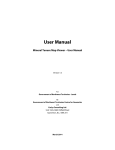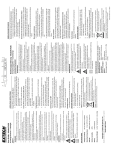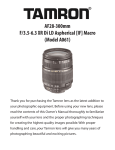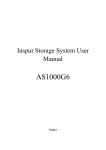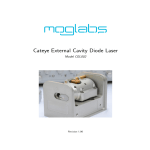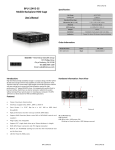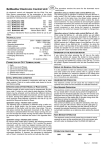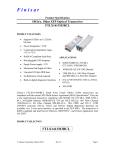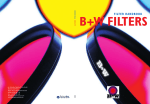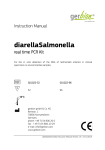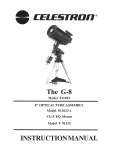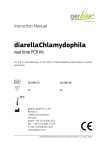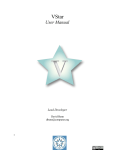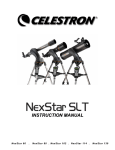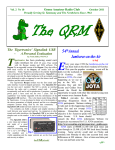Download White Paper: Precision Optical Bandpass Filters
Transcript
White Paper: Precision Optical Bandpass Filters for Solar Research and Observation Copyright 2009 DayStar Filters, LLC, All Rights Reserved Showroom: 14300 Cherry Lane Court Laurel, Maryland 20707 U.S.A. Telephone: 301-953-2000 URL: www.company7.com/daystar/ Correspondence: Box 2587 Montpelier, Maryland 20709-2587 U.S.A. E-Mail: [email protected] DayStar Filters White Paper Precision Optical Bandpass Filters for Solar Research and Observation 2 TABLE OF CONTENTS OVERVIEW ........................................................................................................................... 5 SPECTRAL LINES .................................................................................................................. 6 Hydrogen ......................................................................................................................... 6 Sodium ............................................................................................................................ 7 Calcium ............................................................................................................................ 8 Helium ............................................................................................................................. 9 Other lines ..................................................................................................................... 10 PRINCIPLES OF OPERATION .............................................................................................. 11 Quantum optical design overview ................................................................................ 11 Etalon Center Wavelength ............................................................................................ 11 Etalon Uniformity .......................................................................................................... 14 Etalon Stabilization ....................................................................................................... 15 Environmental Considerations...................................................................................... 15 APPLICATION ..................................................................................................................... 17 Pupil plane .................................................................................................................... 17 Focal plane .................................................................................................................... 17 Instrument choice and consideration ........................................................................... 20 Back focus ..................................................................................................................... 20 ENERGY REJECTION ........................................................................................................... 22 Large aperture energy rejection strategies .................................................................. 23 Too much light .............................................................................................................. 24 ATMOSPHERIC SEEING ...................................................................................................... 25 VISUAL OBSERVATION ...................................................................................................... 26 Eyepiece selection ......................................................................................................... 26 Maximizing contrast ...................................................................................................... 27 IMAGING CONSIDERATIONS ............................................................................................. 28 Choice of camera: go monochrome ............................................................................. 28 Field of view .................................................................................................................. 30 Exposure and File Type ................................................................................................. 30 Newton’s Rings ............................................................................................................. 31 Mosaicing ...................................................................................................................... 31 3 Dynamic range and colorization ................................................................................... 32 Acutance and presentation ........................................................................................... 33 Film imaging .................................................................................................................. 33 SAFETY ............................................................................................................................... 34 OPERATION ....................................................................................................................... 35 CARE AND STORAGE ......................................................................................................... 37 ADAPTER PLATES ............................................................................................................... 39 SPECIFICATIONS ................................................................................................................ 40 APPENDIX A: QUANTUM FILTER WHEEL ........................................................................... 46 APPENDIX B: QUANTUM TURBO ...................................................................................... 47 Copyright © 2009 DayStar Filters, LLC All Rights Reserved. 4 OVERVIEW Developed by Del Woods in the early 1970’s, the DayStar Filters product line has remained a mainstay of academic research for over 30 years. Now, the DayStar Quantum takes a step forward with state of the art electronic controls. DayStar filter assemblies offer seeing limited application, as they are adaptable to a great variety of telescopes or optical laboratory configurations. Superior quality optics ensure a quality and homogeneous sub‐Angstrom bandpass transmission over the entire field of view. Ultra narrow transmissions down to 0.2Å in a single unit make the Quantum a viable option in applications which would otherwise require a Lyot style filter for research, with a much faster production time and cost consideration. Quantum electronics are ideal in remote and dedicated viewing applications where the filter requires remote tuning and or operation via serial interface. The accurate CWL reporting and ±1.0Å CWL tuning feature also offer great benefit for research applications in which precision CWL positioning is critical, such as wing shift studies or in Ca II K‐line atmospheric measurement applications. The Quantum housing is also available as an upgrade to existing DayStar ATM and University Filters already in use. Because DayStar Filters remain serviceable for many decades, filters in operation now may be upgraded to the new Quantum electronics housing package. The DayStar Quantum Bandpass filter is typically applied within the optical path of a telescope or heliostat system for observation of the Sun’s image in certain narrow wavelengths. These wavelengths are most often the strong Fraunhofer spectral lines of Hydrogen Alpha, Calcium II K Line, Sodium D line(s), Calcium II H Line, Helium D3 line, Hydrogen Beta and others. Please refer to the DayStar catalog or website for a current list of available standard center wavelengths, bandwidths, and prices. The bandpass filter is designed to block all light of the solar continuum, but pass the desired narrow bandpass wavelength light emitted or absorbed by the desired element under study. The Hydrogen Alpha wavelength of 6562.8 Å (Angstroms, 1x10‐10m) is chiefly used for photospheric, chromospheric, prominence and atmospheric study of the sun. The DayStar Quantum bandpass filter is applied near the rear of the telescope or optical path rather than before the primary objective. This application within the concentrated beam of the optical path offers seeing limited applications, as it may be applied to a telescope system of any objective size. The same Quantum may also be re‐ 5 applied under different applications on different telescope equipment and in different configurations. Considerations in the configuration must be made to allow light to enter the Quantum filter at a normal angle of incidence. This is accomplished by assuring the light cone is approximately F/30 on encounter with the Quantum filter. The Fabry Perot etalon design offers sub‐angstrom bandpass transmissions of as narrow as 0.2Å FWHM. A precision tuned temperature regulated oven assures accurate wavelength transmission at all times. The Quantum is able to transmit just one wavelength range and is restricted in tuning to ±1.0Å total in steps of 0.1Å. Figure 1: Visible spectrum. Courtesy N.A.Sharp, NOAO/NSO/Kitt Peak FTS/AURA/NSF. SPECTRAL LINES Hydrogen Various wavelengths are typically isolated as they relate to Fraunhofer lines. A majority of Quantum filters are applied in direct observation of the solar disk. Absorption lines of Hydrogen are extensively used for observation of the chromosphere and prominences. The Hydrogen Alpha (Hα) absorption line as observed from within the Earth’s atmosphere has a width of approximately 0.8 Å. Due to the presence of other absorption and emission lines near Hα, a filter of less than 1.0 Å width is required in order to isolate Hα light from the solar continuum. The narrower the FWHM, the greater isolation of desired wavelength and the greater the effective contrast in the observable image through exclusion of continuum and Doppler shifted light. 6 A filter of FWHM 1.0 Å or narrower is required to observe prominence detail. A filter of FWHM 0.7 Å or narrower is preferred to observe prominence detail and spicule. Light emitted from prominences typically travels at such velocity as to exhibit wing shift in red or blue wing. As filter bandpass is reduced, less wing shifted light emitted from prominences is allowed to pass and detail becomes finer in structure. Filters below 0.5 Å FWHM typically do not reveal as significant prominence structure. A filter of FWHM 0.5 Å or narrower is suggested to observe surface structure of the chromosphere, while still revealing prominences. A filter of FWHM 0.4 Å or narrower is required to observe the chromospheric network. A filter of FWHM 0.3 Å is typically used only in research applications, for examination of surface and prominence structure with wing shift effects eliminated. 1 0.9 Spectrum of Sun 0.8 0.7 0.6 0.5 0.4 0.3 0.2 Hydrogen Alpha 6562.8 Å 0.1 0 6548 6553 6558 6563 6568 6573 6578 Wavelength (Angstroms) Figure 2: Hydrogen Alpha spectrum. NSO/Kitt Peak FTS data used here were produced by NSF/NOAO. Sodium Sodium (Na) offers two absorption lines very close together at 5895.9 Å and 5890.0 Å. Filters are manufactured to isolate one or both of these lines for the purpose of Doppler wing shift testing. In such instance, two unique filters are manufactured. Images taken simultaneously may be compared to extract dynamic speeds on the solar surface. 7 1 0.9 Spectrum of Sun 0.8 0.7 0.6 0.5 0.4 0.3 0.2 0.1 Sodium D2 5890.0 Å 0 5878 5883 5888 Sodium D1 5895.9 Å 5893 5898 5903 5908 Wavelength (Angstroms) Figure 3: Sodium D spectrum. Calcium Calcium offers TWO strong absorption lines at 3933 Å and at 3969 Å, known as the K and H lines. Researchers have historically avoided the H line for academic research, as it is very close to the Hydrogen ε line. For purposes of clarity in isolating Calcium, and because imaging sensors offer similar sensitivity to the K and H lines of Calcium, the K line has to date been the target of choice in Calcium filters. Because the blue Calcium K Line (3933 Å) is sensitive to magnetic fields, magnetically active structures show up in high contrast against the surrounding chromosphere. Places where moderate magnetic fields exist show up bright whereas images of high magnetic fields are dark. These studies have been instrumental in determining depth of the solar atmosphere and the study of spectral line formation without the assumption of local thermodynamic equilibrium (LTE). 8 1 0.9 Calcium K 3933.7 Å Spectrum of Sun 0.8 0.7 0.6 0.5 0.4 0.3 0.2 0.1 0 3920 3925 3930 3935 3940 3945 3974 3979 3950 Wavelength (Angstroms) Figure 4: Calcium K spectrum. 1 0.9 Calcium H 3968.5 Å Spectrum of Sun 0.8 0.7 0.6 0.5 0.4 0.3 0.2 0.1 0 3954 3959 3964 3969 3984 Wavelength (Angstroms) Figure 5: Calcium H spectrum. H line is often used because it too offers additional information for study of the solar atmosphere. Numerous groups perform specific investigations of the 3969 Å line, most often in conjunction with K line for studying grain formations due to shock. Studies in Ca II K and H line reveal complex temporal variations in the chromosphere. Helium Studies of the Helium lines are typically involved in research of solar flares. Contours of emission and absorption lines in flares are studied in Helium D3 at 5875.6 Å. Also, two of the most attractive spectral windows for spectropolarimetric investigations of 9 the physical properties of the plasma structures in the solar chromosphere and corona are the ones provided by the spectral lines of the He I 10830 Å and D3 multiplets, whose polarization signals are sensitive to the Hanle and Zeeman effects. The 10830 Å line offers significant information, but is only applicable from high altitude and space‐borne viewing platforms due to the interference of terrestrial Oxygen lines. The line is also in the infrared, where the quantum efficiency of most Silicon‐based CCD cameras is very low due to the proximity of the Silicon bandgap. Special IR wavelength imaging sensors are required for such an application. Alternatively, the He D3 line offers value in terrestrial applications. Isolation and identification of the line is a challenge due to the narrow width of its absorption line and proximity to other lines. Very narrow FWHM and precise tuning is critical for proper isolation. 1 0.9 Spectrum of Sun 0.8 0.7 Helium D3 5875.6 Å (Emission line) 0.6 0.5 0.4 0.3 0.2 0.1 0 5860 5865 5870 5875 5880 5885 5890 Wavelength (Angstroms) Figure 6: Helium D3 spectrum. Other lines Other lines in the chromospheric spectra are determined by the specific research goals proposed by any research application. Other known lines of study include Mg I, Fe XIV, Cn I and Hß. Not all Fraunhofer lines are suggested for study, due to interference from atmospheric elements. Fe XIV and Mg I are common lines of study in the spectrum of the Corona. Absorption lines of the coronal spectra vary greatly from that of the photospheric spectra. DayStar can manufacture filters to custom wavelength and FWHM specifications for wavelengths from 3800 Å to 7000 Å. Center wavelengths from 3500 Å to 8000 Å are available with restrictions. 10 PRINCIPLES OF OPERATION Quantum optical design overview A multi‐element filter stack is assembled from various components. Exterior surfaces are ¼ wave accurate or better, AR coated BK7 glass. The heart of the filter is a solid spaced Fabry‐Perot etalon manufactured with high finesse and low fringing that exhibits multiple high‐transmission peaks in successive orders with FWHM as low as 0.3 Å. For FWHM’s of 0.2 Å, two matched etalons are stacked. A blocking filter of 10 Å FWHM then blocks the undesired orders. Finally, a trim filter offers blocking of off band light by a factor of 1x10‐4 from X‐ray to Far Infrared. Colored or neutral density elements may also be added to the filter stack to reduce the transmission to a comfortable level, if necessary. Solid spaced etalons are fabricated by coating reflective and anti‐reflective coatings directly onto cleaved and graded mica crystal wafers. The surface figure of the cleaved crystal is uniform to a molecular level. The resulting surface figure, wavefront properties, stable solid mounting and homogeneity of the prepared etalon crystal assures continuous uniformity in CWL, FWHM, and transmission across the entire clear and usable aperture. A light beam passing through the optical assembly will maintain the limiting resolution of the original light gathering aperture. Mounted in a rear‐mounted collimated configuration, the Quantum bandpass filter may be applied to instruments of any aperture and is therefore diffraction limited. Etalon Center Wavelength The varying transmission function of an etalon is caused by interference between the multiple reflections of light between the two reflecting surfaces. Constructive interference occurs if the transmitted beams are in phase, and this corresponds to a high‐ transmission peak of the etalon. If the transmitted beams are out‐of‐phase, destructive interference occurs and this corresponds to a transmission minimum. Whether the multiply‐reflected beams are in‐phase or not depends on the wavelength of the light (in vacuum), the angle the light travels through the etalon, the thickness of the etalon, and the refractive index of the material between the reflecting surfaces. 11 100% 90% Finesse = 2 Etalon Transmission 80% 70% 60% 50% 40% Finesse = 90 DayStar 0.3Å 30% Finesse = 17 20% 10% 0% 6525 6530 6535 6540 6545 6550 6555 6560 6565 6570 6575 Wavelength (Angstroms) Figure 7: Etalon finesse. The reflectivity of the etalon coating determines the finesse of the etalon, and consequently the FWHM. Higher finesse etalons show sharper transmission peaks with lower minimum transmission coefficients. The average finesse of a DayStar etalon is 55, with finesses up to 90 employed for special applications. Etalon Transmission 100% 50% FWHM 0% 6562.0 6562.2 6562.4 6562.6 6562.8 6563.0 Wavelength (Angstroms) Figure 8: FWHM means full width at half maximum. 12 6563.2 6563.4 6563.6 A Fabry‐Pérot etalon changes peak transmission wavelength with changing distance between the reflective sides. This can occur by a change in temperature through thermal expansion of the mica wafer. In order to maintain the center wavelength (CWL) of the Fabry‐Pérot etalon in conditions of varying environmental temperature, a consideration for tuning must be made. An increase in temperature causes an increase of the CWL of transmission peaks. The etalon varies 1.0Å per 17.0 °F (9.4 °C). The Quantum uses a temperature regulated oven to effect tuning and control of wavelength. Peak transmission wavelength will also change with the angle of incidence of light encountering the Fabry‐Pérot etalon, due to the longer path length when light traverses the mica at an angle. A tilt of the Fabry‐Pérot etalon crystal causes a shift towards the blue, causing a decrease in the CWL transmitted regardless of the direction of the tilt. In addition to blue wing CWL shift, the FWHM of the transmitted light will widen with tilt. As demonstrated in the following chart of measured CWL shift versus angle of incidence, angles must be kept under one degree for the filter to perform to specification. 0 CWL Shift (Angstroms) ‐5 ‐10 ‐15 ‐20 ‐25 ‐30 0 1 2 3 4 5 6 7 8 9 Angle of Incidence (Degrees) Figure 9: Center wavelength shift with angle of incidence. This tilt dependence results in a cumulative FWHM widening in optical paths with a fast focal length light cone. The center of the light cone has zero angle of incidence and therefore zero shift, while light from the extremity of the light cone will pass through at an angle and be shifted lower, altogether resulting in a wider effective bandpass. Therefore, it is necessary to configure the focal ratio of the optical path to achieve slow or long focal ratios. Simple geometry shows that to keep the angle of incidence below one degree, the 1 focal ratio of the telescope system must be longer than ( 2 tan 1° ) or F/28 for bandpass applications of less than 1.0 Å FWHM. Applications of 2.0 Å and wider filters can tolerate two degrees of tilt and should therefore be configured with a focal ratio of F/15 or above. 13 Etalon Uniformity The solid substrate of Fabry‐Perot etalon crystals ensures a higher figure surface quality on which coatings are laid. Naturally grown, high grade optical mica is used for its properties in cleaving. The crystal structure of mica can be described as being a series of parallel sheets, so that it may be cleaved into parallel layers to a molecular level. Mica wafers must be cleaved by hand, with consequent yield loss due to the tendency of mica to jump layers, which can cause a Figure 10: Raw mica. step in CWL. Mica wafers are graded for homogeneity within the structure of the sample. Natural mineral formations generate areas of higher and lower concentrations of elements, altering the index of refraction across the sample. Candidate etalons are selected for areas of maximum homogeneity across the sample aperture needed to construct the etalon crystal. Areas larger than 50mm of homogeneous uniformity are extremely scarce. Once coated with reflective and anti‐reflective coatings to amplify the finesse and migrate the transmission peak to its desired wavelength, etalon crystals are seated with high temperature rated optical couplant, in ¼ wave BK7 optical windows. In order to prevent damage to the crystal in any future servicing of the filter, the optical couplant properties must permit it to remain viscous and transparent for 20 years or more. Once the etalon crystal has been seated in BK7 windows, it cannot safely be separated or un‐ seated without risk of damage to the crystal. Etalons seated in this manner are not affected by changes in atmospheric pressure associated with altitude. Etalon crystals are characterized and graded by a 1 meter focal length spectrometer with a custom built X‐Y scanning stage to map the distribution of nonuniformities. Etalons are graded at full aperture and at reduced aperture sample areas for CWL and bandpass testing. For PE (Professional Edition) grade etalons, the mean peak wavelength of all 12mm diameter areas is specified to lie within ±0.1 angstroms of the full aperture wavelength Figure 11: Uniformity testing a 2” etalon. measurement. Less than 5% of etalons qualify to PE grade. SE (Standard Edition) grade etalons do not have a guaranteed uniformity, but operationally are kept within ±0.5 angstroms of the full aperture measurement. 14 Etalon Stabilization As thermal expansion of the core mica crystal will cause the CWL of the etalon to vary, regulation of the etalon temperature is necessary for precision control over wavelength. The Quantum uses an aluminum ring surrounding the optical stack to maintain an even temperature and transmission CWL. The low thermal conductivity of glass dictates that heat will radiate through the entire optical stack slowly from the outer diameter in towards the center of the aperture. During the time when the unit is heating or cooling, the CWL in the center of the aperture will be at a different CWL than at the edge of the aperture. The temperature sensor used for indication of temperature and CWL is located on the outside of the optical stack. Therefore, the indicated wavelength on the LCD will differ from the CWL passed through the central core of the filter while it is heating and/or settling. During this time, the LED light on the Quantum faceplate will be orange. A green LED light will indicate when an appropriate amount of time has passed in order for the temperature to settle throughout the unit. When moving down in wavelength, additional time may be required if ambient air temperatures are high, as the Quantum uses only passive cooling. For applications requiring rapid tuning, the only feasible method of tuning is tilt. DayStar manufactures manually (thumbscrew) tuned filters under the T‐Scanner and Quantum‐2 (TS‐2) line of filters. A precision motorized tilt version of the Quantum is under development for possible future release to researchers needing near instant tuning. Environmental Considerations The Quantum is intended for use in normal atmospheric conditions, and as such is not rated for use in a vacuum, at extreme temperatures, or in the presence of radiation. Filters for such environments are developed on a custom basis. The Quantum filter is best stored in a sealed, humidity controlled case containing desiccant. Ideally, the filter should be stored in a climate controlled environment of 73°F with humidity of under 20%. This will increase the life expectancy of blocking filter elements within the optical assembly which age faster in heat and humidity. Filters stored in such conditions have lasted in excess of 20 years. The Quantum filter is very durable to shock impact. The etalon crystal of the filter is seated deeply within many layers of glass in a metal cell, which is air‐spaced inside an outer aluminum ring. Extra caution is not required for shock resistance to a closed and fully assembled Quantum oven assembly. The filter stack assembly, however, is very susceptible to damage should the optical housing be opened or tampered with. The optical stack is housed under slight compression to maintain equal and even pressure between the optical layers over a many decade lifespan. Often, when that pressure is released, air can enter the filter stack and/or visible creases form in the lubricated cavities created with that release of pressure. The result can be air bubbles and/or spider veins in the assembly. Damage occurs when elements are separated, twisted, pulled or slid against one another; or even the release of 15 tension in opening the filter assembly. That motion causes sections of the coating to slide, clump or vein in effects as light as crackling or severe as complete coating failure. Undisturbed etalon crystals have been found to last in excess of 30 years with no aging or degradation. 16 APPLICATION Careful attention to the focal ratio of light passing through the Quantum filter is necessary for the filter to perform to specification. Two methods of application are typically employed. Pupil plane Large aperture or professional applications often involve a pupil plane configuration, where light from the telescope is recollimated back to infinite focus through lenses on an optical bench or assembly. This is functionally equivalent to placing the filter in front of the objective, but with the advantage of squeezing a larger aperture through the 32 or 45mm clear aperture of the Quantum. After the filter, focusing optics are used to bring the light beam back to an appropriate focal length for observation. Besides the aperture advantage, this allows for an arbitrary plate scale at the imaging sensor, to achieve the desired field of view. CWL tuning and wavefront accuracy requirements are more stringent for pupil plane versus focal plane applications. Therefore, when ordering a Quantum for use in a pupil plane application, be sure to note this on the order or in discussions with DayStar so that the appropriate testing procedures are performed at the factory. Focal plane Due to the complexity and custom nature of pupil plane installations, focal plane setups are far more common and popular. Here the filter is placed in a sufficiently slow focal beam, near the point of focus, such that the converging light cone fits through the 32 or 45mm clear aperture of the Quantum. In this way no additional focusing optics are required beyond the telescope objective. In focal plane telescope applications, focal ratio is an important consideration if the desired sub‐angstrom bandpass is to be accomplished. Angular light of fast focal ratios causes a cumulative widening of FWHM due to tilt‐effect blue wing shift of light transmitted. Focal ratios of F/28 – F/35 are ideal for filters of 1.0Å or less. Focal ratios of F/15 – F/20 are appropriate for filters of 2.0 – 5.0Å. The following chart models the impact of a faster‐than‐recommended focal ratio on a 0.5 Å Quantum filter. As the focal ratio shortens towards the left of the chart, the FWHM quickly exceeds a usable value. In addition to the overall widening, a pronounced hot spot effect occurs at low focal ratios as the center of the field of view experiences less angle of incidence as compared to the outer areas. 17 0.5Å Nominal Filter FWHM (Angstroms) 2.25 2.00 1.75 1.50 1.25 1.00 0.75 0.50 10 15 20 25 30 Telescope Focal Ratio (F/ number) Figure 12: FWHM widening with suboptimal focal ratios. Focal ratio may be manipulated in telescope applications by a choice of methods. Masking the aperture of a fast focal ratio objective will increase the focal ratio proportionally. For example, a 100mm F/15 objective reduced to 50mm will result in F/30. In this application, the effective focal length (EFL) of the telescope is not changed. Resolution is reduced, however. Refracting telescopes require an on‐axis aperture reduction. When using a refracting telescope, introduction of a negative lens in the optical path prior to the Quantum filter will also increase the operative focal ratio of the optical system proportionally. For example, a 100mm F/7.5 objective with 4X negative lens applied will result in F/30. In this application, the effective focal length (EFL) of the telescope will increase proportionally as well. Resolution will not be reduced. A single element negative lens will typically offer adverse effects in light drop‐off vignetting and in radial bandpass FWHM widening from angular light at the outer diameter of the negative lens. A multiple element telecentric negative is suggested. Certain telecentric lenses (barlows) are commercially available in 2X, 2.5X and 4X focal lengths. One manufacturer offers direct coupling of telecentric negative lenses to the Quantum with T‐thread coupling. A combination of aperture reduction and negative lens application may be necessary for the application depending on the telescope equipment under consideration in order to achieve the desired effective focal length and image size. Both functions are in directly proportional scale and may be easily computed. A focal reducer or positive lens may be applied after the Quantum filter in order to reduce the effective focal length should a smaller image size be desired for visual or photographic applications. Resolution is not affected by introduction of a focal reduction lens. SCT sized focal reduction lenses may be coupled directly to the Quantum as it is 18 manufactured with a standard rear SCT male thread. However, any non‐telecentricity of the barlow will be amplified, limiting the usable field of view unless care is taken in the selection of the barlow. Figure 13: Angle of light entering the filter should be at ~F/30. When using larger aperture reflector telescopes, an aperture reduction mask and an off‐axis energy rejection pre‐filter is suggested. Unfiltered, full spectrum sunlight should not be allowed to enter a large aperture, closed tube SCT telescope or overheating and damage may occur. Concentrated light which encounters the secondary mirror will cause heating and possibly adhesive failure to the secondary mirror, which would cause it to fall onto the primary mirror. Sunlight entering an unprotected SCT telescope also causes convective heating inside the optical tube assembly and the associated negative seeing affects. Light passing through the off‐axis aperture mask will result in light exiting the telescope’s optical path off‐axis. In consideration for the exit angle of light from the off‐ axis SCT, a small wedge plate is applied to the front of the Quantum. A wedge plate of a 1.6° angle is required for telescopes with focal ratios of F/8‐10. A wedge plate of 1.4° is required for telescopes with focal ratios of F/12‐15. The angle of this wedge plate must be aligned to the orientation of the off‐axis aperture mask. 19 Instrument choice and consideration The Quantum filter may be used in a wide variety of telescope configurations. Selection of the ideal telescope should include consideration for desired focal length and resolution. Low focal length applications require aperture reduction. High focal length, high resolution goals suggest application of a negative lens to achieve F/30. As the function of the Quantum is to pass only a very small wavelength range of light, it is not necessary to use optics with quality color correction. Apochromatic telescopes do not offer significant advantages over achromats except perhaps for field flatness. Back focus In‐focus and back focus is a concern for successful configurations. Occasionally in reflector applications, a telescope may fail to have the necessary in‐focus needed to introduce the Quantum. These are very uncommon outside of the Newtonian design. A list of known occurrences is available from the manufacturer. Newtonian and Dobsonian telescopes typically make poor candidates for application of the Quantum for solar viewing. The focal point of a Newtonian or Dobsonian telescope is typically designed to fall within the basket or optical telescope assembly for the direct application of user eyepieces or cameras, with little spare backfocus. Introduction of the Quantum components require more focus travel than most Newtonians and Dobsonians permit. Some Gregorian telescopes, with adjustable secondary position, have been used for application of the rear‐mount bandpass filter. Figure 14: Off‐axis Energy rejection filter. Maksutov telescopes can also suffer difficulties due to the large size of the secondary element. Light passing predominantly through the outer diameter results in wing shift difficulties and bandpass broadening. In any telescope system, a number of concerns remain constant and must be considered. Scattered light from internal surfaces within the optical tube assembly, or reflections off poorly coated elements, can result in transmission of off‐band light through the Quantum filter and decreased contrast. Added weight of equipment to the rear of the telescope can also cause flexure in weak telescope components which may not be designed for the Quantum filter and 20 associated accessories. As A the introd duction of a a negative lens increasees the telesscope focal length, th his can also cause the o object to mo ove significaantly back in n the focus ttrain. Thee associated d weight of the t Quantum and acceessories is off greater co oncern at greater extension of a telescope focusing f tub be. Flexuree of the focu using tube can c cause lo oss of colllimation of tthe optical syystem, shiftiing the CWLL of the filterr bandpass lo ower. Introduction of a n negative lenss, and the p position in th he optical path in which h the neggative lens is i introduced will greattly affect the subsequent back focus needed. The imp pact of the iincreased fo ocal length is lessened w when the neegative lens and subseq quent Quaantum filterr are introdu uced farther back in the optical path h. Typically, an introduction afteer a diagonaal will signifficantly redu uce the lenggth of the teelescope and the assocciated weight and flexxure of the telescope and focuser tu ubes. The relaation between the amplification facctor A, the ffocal length FB of the Baarlow lens and the disstance D bettween the leens and the object is: A == D/OB + 1 Figgure 15: Barlow lens changes po osition of focal p plane. nd O2 is a fu unction of distance d from m the objecct, it is thereefore As Focaal Length an portant to co onsider the location wh here the neggative lens iss introduced d. If a 4x leens is imp intrroduced 100 0mm before the O1 theen the position of O2 is 400mm beh hind the neggative lens and a nett result of an additional 300mm in n new back focus required. Addittional focus length co onstructed of o long exteension tubess usually un nbalances th he telescopee and cau uses de‐collim mation of th he optical path through ssagging of th he focuser drawtube. Howeve er, introduction of the same 4X negative n len ns 10mm before b O1 would w create only 40m mm behind tthe negativee lens and a net 30mm n needed in neew back focu us. The sim mplest solutio on to this co oncern is to o apply the n negative len ns farther baack in thee focus train;; specifically, after a diaggonal mirrorr. 21 ENERGY REJECTION Energy rejection must be considered on all telescope applications of aperture above 50mm. Excess radiation entering the telescope from UV, Visual and IR light can cause excessive heat load to the instrument. Without proper prefiltering, even moderate apertures can cause a sufficiently large heat load to overcome the regulating capacity of the oven and cause the filter’s CWL to drift off band, or cause local seeing cells inside the telescope tube that blur fine details. Larger amounts of excess heat in the optical assembly can cause optical elements to thermally expand and crack, causing damage to the optical instruments. Heat is also known to cause mounting cements to release and damage coatings or optical couplants which might be positioned in a location that encounters a focused or near focused beam. Therefore, any optical surface which encounters a concentrated beam should be protected from excess radiation via an Energy Rejection Filter (ERF). As a great deal of heat is generated in UV, colored glass is commonly used as a pre‐ filter before a telescope’s objective in order to cut UV light as well as light below the cut point of that color of glass. Typically a red colored optical window will cut all light below 6000 Å. A yellow glass optical window will cut all light below 5000 Å. A red or yellow colored glass window ERF may not be used when attempting to pass wavelengths less than the corresponding ERF color such as Calcium II K‐Line, found at 3933 Å. As colored glass optical windows reject by absorption, they may not be applied within the optical plane behind the front objective. Should a red glass ERF be introduced at the rear of the light path, thermal expansion of the glass would cause it to grow in its cell and break. A colored glass ERF pre‐filter mounted before the objective should be manufactured to the same or higher figure tolerances to the objective for which it is applied. Consideration should also be made for the glass thickness ratio of the substrate in order to assure its flatness is maintained and the glass does not experience flexure from sagging. An ERF with a figure will cause aberrations in the resulting images through the instrument. Some instrument configurations suggest the introduction of a dielectric ‘hot mirror’ for energy rejection. Dielectric hot mirrors reject by reflection rather than through absorption. Therefore, the mirror may sustain a greater energy load and result in less heat expansion than colored glass energy rejection filters. The coating reflects UV and/or IR energy as an optical flat mirror, but passes visual light as an optical window. Application of a dielectric hot mirror is appropriate in configurations for wavelengths lower than available colored glass windows such as Ca II K and Ca II H line as well as Cn, Mg, Fe XIV and Hß lines. The application may also be used when colored glass is not available in the desired clear aperture. The dielectric hot mirror may also be applied as an additional level of energy rejection, as colored glass does not block IR from entering the system. Reflected light from the dielectric hot mirror reflects at opposite angle as encountered, passing back through objective elements at the original incident angle and focus concentration. The dielectric hot mirror may be introduced to encounter concentrated light near focus. However, it must be introduced prior to any optical 22 elements such as a secondary or diagonal mirror, as those elements would be subject to stress, loss of figure, expansion and cracking due to excessive heat load. Various dielectric hot mirrors designed to block UV or IR, but pass visual light, are marketed for photographic and astronomical applications as UV, IR or UV/IR cut filters. Application of the hot mirror coating tends to deform the figure of the substrate on which it is applied. Most large area products termed as “hot mirrors” are produced on borofloat glass in thicknesses of only 2mm – 3mm. The surface flatness of such hot mirrors is therefore usually too irregular to use as an energy rejection prefilter. Astronomical UV/IR cut filters manufactured with this coating in 1.5” and 2” circular aperture have far superior wave front tolerances which may be introduced into the optical path without impact. The cut points of UV/IR cut filters often occur near or at 4000 Å and can obstruct or attenuate transmission of 3933 or 3969 Å Calcium lines. Care should be taken in selection of UV cut filters for these applications. Large aperture energy rejection strategies In certain applications of large telescopes where a clear aperture greater than 150mm is planned for use, energy rejection becomes a more serious issue. Colored glass which is typically used for energy rejection is not available in large aperture and thickness. As front mount glass must maintain a surface figure, the energy rejection filter must be made to at least 1:10 thickness in order to maintain a quality surface figure. Application of this large and heavy optical cell is also prohibitively heavy for mounting in the front of the telescope’s objective. Therefore, alternative applications are appropriate. Refracting telescopes of larger than 150mm aperture may introduce a dielectric hot mirror towards the rear of the optical path, before any optical element which would encounter concentrated light. This includes the negative lens, a diagonal, a field flattener or neutral density filter. Telescopes of extremely large aperture such as those over 500mm will require the application of neutral density film applied before the primary of the telescope, or a complicated heat dump system to reject light outside of a narrow field of view. Films are commercially available which reduce transmission across the entire spectrum by approximately 50% when applied as a pre‐filter. The light gathering capacity of the very large objective assures that sufficient light volume will be passed through the Quantum for research purposes. After the neutral density pre‐filter, a dielectric hot mirror is suggested in addition, mounted before any elements which encounter a concentrated beam. A heat dump or heat stop typically consists of a reflective disk or cone with a central perforation, located very near the focal point of the primary mirror in a professional telescope. A portion of the Sun’s disk is allowed to pass through, with the majority of the Sun’s light reflected away, either back out or to the side, sometimes into a purposely designed heat dump to dissipate the heat in a manner that will not affect seeing inside the instrument. 23 Too much light Occasionally, transmission is too high through the Quantum for certain applications such as CCD imaging of emission lines of the spectrum or where large aperture is being used to accomplish high resolution. Introduction of a neutral density filter may be called for. Transmission percentages of a Quantum are 4‐12% of polarized light, so orientation of polarizing neutral density filters may affect net transmission. Introduction of the polarizer should be after energy rejection or after the Quantum. Neutral density filters are subject to overheating and damage if exposed to full spectrum concentrated light. CCD, photometer and Photomultiplier tubes may require reduction of transmission due to sensitivity. Aperture reduction should be considered first, but if reduction is not an option, a neutral density filter may be applied. 24 ATMOSPHERIC SEEING Local seeing conditions are usually the determining factor in the limiting resolution of the telescope system. Daytime seeing cells are of serious concern and should be considered early. Daytime seeing is affected by changes in temperature within the atmosphere between the sun and the observer. Most seeing impact occurs in the lowest 30 feet above the ground. As surfaces absorb solar radiation throughout the day, that radiation is continually released into neighboring air. Dark colored surfaces absorb more heat than light colored surfaces. Asphalt, roofing shingles, concrete, dark buildings, brick and pavement all impact local seeing significantly. Grass impacts local seeing the least. Air flow and turbulence over irregular objects such as trees or buildings can also adversely affect seeing. Laminar air flows move evenly over smooth surfaces such as open fields and bodies of water. Large bodies of water also sink solar radiation away from the surface and improve seeing conditions above. Seeing cells in the upper atmosphere are not affected by local circumstances. Ice crystals in the upper atmosphere, high cirrus clouds, the jet stream and water vapor affect seeing regionally. A telescope of arcsecond, or sub‐arcsecond resolution may not be capable of obtaining this resolution if either local or regional seeing does not support the atmospheric clarity. Thermal cells can affect focus. It is therefore, necessary to focus very slowly and to consider seeing variations while focusing the telescope or imaging system. Fluctuations in seeing will most certainly affect the sharpness of an image captured. Visual observations at high resolution may succeed due to the human eye’s ability to sort and process occasional ‘lucky’ seeing cells. Still photography using telescopes which exceed the local seeing circumstances and only a small number of exposures are very unlikely to exceed local seeing conditions. In general, for areas of less than exceptional seeing conditions, a daytime seeing limit of 90mm in aperture is accepted. However, when imaging in multiple exposure or fast‐ frame photography, that seeing limit no longer applies. High speed capture methods such as video cameras or webcams which capture many consecutive frames often offer higher quality results. The high speed camera captures dozens or hundreds of images which can be sorted and selected for sharpness. Fast frame photography or ‘lucky imaging’ can capture many frames and sort images for sharpness to discard images with poor sharpness and keep images with good sharpness values. This process is called “image sorting”. No stacking is required in lucky imaging. Stacking images has a limited application in high magnification applications, as the surface features photographed can move and change very quickly, or be distorted from selected frame to selected frame by changes in seeing. Stacking is only viable when hundreds of frames can be combined to achieve a very high signal to noise ratio, so that very aggressive sharpening routines can be applied. 25 VISUAL OBSERVATION Eyepiece selection A configuration which uses a negative lens to accomplish F/30 will have a very large focal length and low power eyepieces of 30‐50mm are suggested for full disk viewing. Higher power eyepieces are appropriate if the seeing supports higher magnification. A configuration with aperture reduction will benefit from the same eyepiece choices as the telescope ordinarily uses. Many modern style wide apparent field eyepieces are designed for fast focal ratio applications. Viewing at long focal ratios with these fast focal ratio eyepieces usually results in vignetting and poor exit pupil matching. Telescope diffraction limited resolving power (as modeled by Dawes’ limit, the Rayleigh Criterion, and others) is also a concern when operating at F/30. High powered eyepieces which exceed the resolving power will produce negative effects. The eye has more difficulty distinguishing large scale low contrast features than small ones. Image brightness will be negatively impacted, as the light is being spread unnecessarily thin, without any finer details becoming visible. Focus at high magnification can also be very challenging, as the chromosphere softens the limb of the sun. It is important to include time to incorporate seeing changes in the focusing process to avoid ill effects. Figure 16: Visual observation through a refractor. λ The Rayleigh Criterion is expressed as follows: sin θ = 1.22 D , where θ is the angular resolution, λ is the wavelength, and D is the diameter of the telescope aperture. If the telescope is stopped down, the stopdown aperture should be used in calculations, not the full masked aperture. For Hα solar observing, the criterion can be simplified to θ = 165 D , where D is the telescope aperture in millimeters, and θ is the diffraction limited resolution expressed in arcseconds. As an example, a telescope of 100mm aperture 26 would not be expected to reveal details smaller than 1.65 arcseconds in extent, unless they are very high contrast. Once the limiting resolution is determined, maximum magnification can be calculated. The average resolving power of the naked eye is approximately 60 60 arcseconds. Therefore, magnifications increasingly above θ will look progressively blurrier due to diffraction. Personal visual acuity, experience, and taste cause this to be a guideline rather than a rule. The minimum recommended eyepiece focal length can then FL x 165 be expressed as 60 x D where FL is the telescope focal length, including any barlow. The previous expression can be further simplified to the very handy relationship of EpFL = 2.75 FR, where EpFL is the optimal eyepiece focal length and FR is the telescope focal ratio. Eyepieces near this value will fully exploit the available resolution of the telescope. Conservatively rounding down the 2.75 focal ratio factor to 2 for margin indicates that at F/30 eyepieces shorter than 60mm outresolve the diffraction limit and offer little or no benefit for well‐sighted observers. For the sharpest and brightest looking image, use as wide an eyepiece as possible. Employing eyepieces far below the guideline, such as 25mm or 12mm, will result in a disappointingly blurry and dim image. Maximizing contrast Dark adaptation is important for solar observing. The 4‐12% transmission of the Quantum will require a certain degree of dark adaptation in order to maximize the full contrast of the sun’s image. Observers will want to consider sun shades, dark cloth drape, darkened or shaded areas where the eye can adjust to lower light levels. Reflected light from the ground or objects below the telescope have a big impact on dark adaption. White or light surfaces should be avoided in working areas for visual observing the sun through the Quantum. Observers should consider the use of eyepieces with an eye‐cup and may also benefit from an eye patch or keeping the observing eye closed immediately before viewing. Binocular viewing offers a great deal of added contrast for visual solar observing. The nature of the way the human eye perceives contrast differently in different eyes, as well as in different areas of an eye’s peripheral vision adds contrast to the visual experience when two eyepieces are used. Care should be taken with binocular viewer prisms. Many prisms polarize light on reflection to the second eyepiece. Rotation of the Quantum filter may be required to align polarity of the binocular‐viewer prism, to balance the brightness in each eye. 27 IMAGING CONSIDERATIONS Choice of camera: go monochrome Successful imaging through the Quantum is strongly influenced by the choice of camera. While just about any camera will produce an image with recognizable features, large improvements in image quality can be obtained when matching the camera to the application. The primary factor in image quality is that of choosing a monochrome camera over a color one. Virtually all color cameras contain an internal Bayer color filter array that passes only one of red, green, or blue light for any given pixel. Only 1 in 4 pixels have red sensitivity. A color camera advertised as 16 megapixels performs as a 4 megapixel camera on H alpha or Calcium, for example. Additonally, the color filter in the camera may have a cut point near H Figure 17: Raw H‐alpha image from a Canon EOS 5D sensor. alpha or Calcium, reducing the Only 1 in 4 pixels is sensitive to red light. sensitivity. A monochrome camera of the same specifications would have four times the resolution and more sensitivity. Color cameras frequently internally average or smooth adjacent pixels to reduce noise, further compounding the loss of resolution. Resolution robbing compression is also standard in low end color cameras producing JPEG or video files. In most cases color changes are recorded at only half the resolution of brightnesses. Color cameras also must contain some form of infrared blocking. Unfortunately the cut point of the IR blocking often falls below the wavelength of H alpha, resulting in a transmission of only a couple of percent. A good monochrome camera is immune to all these effects. As with the issue of matching eyepiece focal length to the telescope focal ratio, camera pixel pitch should also be matched to Figure 18: The construction of a color camera includes a number of the telescope they will be photon‐robbing features. used upon. Pixel pitch is the 28 Sharpness width of each pixel in a camera sensor, commonly from 1 to 30 microns. For example, if the diffraction limited resolution is two arcseconds, it makes little sense to image with a plate scale of 0.5 arcseconds per pixel or below. That would spread the light across too many pixels, reducing the signal to noise ratio as each pixel has a noise contribution, and limiting the field of view that would otherwise be obtainable. Using the Rayleigh criterion in a similar way as was derived in the Visual Observing FR section, one can obtain the relationship P = 2.5 for H‐alpha light with a monochrome camera, where P is the pixel pitch in microns (0.001 millimeter) and FR is the focal ratio of the telescope. This includes a consideration for information theory, where it is necessary for two pixels to represent each feature. For an F/30 light cone, the diffraction limited pixel pitch is therefore 12μm (0.012mm). If one is limited to a camera with pixels significantly less than that size, a focal reducer is recommended to better match the target size. Alternatively, it may be advantageous to bin 2x2 or 3x3 pixels together. As the pixels do not contain differing information, the averaging will significantly reduce noise and allow more aggressive sharpening techniques without any real loss of resolution. The next consideration in choosing a camera is that of frame rate. The faster the camera can acquire frames, the better your chances of beating the seeing through lucky imaging. Cells of steady air are fleeting and few, so a high frame rate is needed to maximize the 0 1 2 3 4 5 6 7 8 chances of catching them Time (Seconds) and obtaining sharp images. Frame rates of 10 Figure 19: Atmospheric seeing varies quickly in this 12fps data session. to 60 frames per second are ideal. Cameras with slower rates will have to settle for less than ideal seeing conditions, or be exposed repeatedly for tens of minutes to obtain a sharp frame under poor seeing conditions. Closely related to frame rate is the issue of transfer speed. Parallel printer port, USB 1.0, or other old technologies are a poor match for solar observing. Even if the image sensor is capable of a fast exposure, a slow interface will limit the real world achievable frame rate. Gigabit Ethernet (GigE), USB 2.0 or 3.0, CameraLink, or Firewire are all appropriate interfaces for a solar camera. Bit depth is a crude measure of the dynamic range of a camera but is a good indicator of how far images will be capable of being processed. 8 bit cameras offer little to no headroom for brightness, color, or sharpening adjustments after the image is 29 captured. 12 or 16 bit cameras preserve the data much more precisely, allowing strong level shifts, unsharp mask, or other processing with no visible degradation of the image. Field of view Some applications call for imaging of the entire solar disk in one field of view. Other applications suggest a higher magnification and smaller field of view. Field of view is an important consideration in selection of the telescope, aperture mask and/or negative lens to be used, as the F/30 focal ratio usually results in very high magnification and a small field of view. This is desirable for imaging of fine structure and study of specific features and details. However, those who intend to image the full solar disk should consider a focal reducer applied after the Quantum in order to reduce the focal length. Additionally, aperture reduction and lower power negative lens should be considered. Figure 20: Imaging through a Quantum. Courtesy Theirry Legault. Exposure and File Type When operating the camera, ideally one would set the exposure such that the image features are recorded brightly, without clipping. “Expose to the right” is a catchphrase referring to the practice of adjusting the exposure time until values in a histogram nearly touch the right (bright) edge. Alternatively, examine the brightest features in the image and check for clipping, where they lose detail and wash out. On occasions of poor seeing, sharpness may be valued over noise, in which case it is worth abandoning a proper exposure and setting the exposure time artificially short. This will serve to freeze the seeing. Levels can later be brought up in post processing. 30 It is important to save all images in a lossless format that does not discard fine details. JPEG files, while saving disk space, cost dearly in their ability to preserve fine detail for later processing. Always save images in the most raw, lossless format allowed. Good choices are FITS, TIFF, or the camera’s proprietary raw format. Newton’s Rings Many digital image sensors suffer from a phenomenon known as Newton’s Rings, interference fringes, or interference patterns. These wavy lines are caused by reflections inside the image sensor. Some cameras are Figure 21: Newton's Rings, with camera normal (left) and tilted (right). more prone to the problem than others. High end cameras sometimes show the problem worse due to the close tolerances of their manufacture effectively creating an etalon between two slightly reflective surfaces! Unfortunately there are no hard and fast rules for knowing whether a camera will be susceptible before purchasing, other than asking other users of that camera if they have encountered the problem. The solution to the fringes can be quite simple; tilting the camera detunes the reflections just as tilting an etalon detunes the center wavelength. For this reason, DayStar offers the T‐threaded Interference Eliminator accessory to effect a controlled tilt of up to five degrees, which is sufficient to abate the problem on all but the most seriously affected cameras. Mosaicing Often, when imaging at very long focal lengths and high magnification, it becomes necessary to tile the image and generate a composite. In this application, inhomogeneous areas of the SE grade substrate of the etalon crystal will become noticeable. Areas of slightly lower and higher CWL or wider and narrower FWHM will appear in an image as slightly lighter or darker areas. When tiled together in a composite, these areas become more apparent due to their repetition. 31 PE grade etalon crystals will tile with much more accuracy. A PE grade etalon crystal can, however, still display very slight variations in brightness, while still operating within the technical tolerance of its bandpass and wavelength uniformity, if aggressive processing is applied. To remove these slight variations in brightness, a flat field is recommended. Defocusing the telescope or covering the front aperture with a diffusing material sufficient to remove any trace of features on the Sun will provide the best flat field. Then raw images should be divided by the flat field in any popular astronomical imaging program before assembling the mosaic. Dynamic range and colorization Monochromatic light such as Hα appears during visual observation as various brightnesses of the same color. Due to the enormous dynamic range of the eye, both surface details as well as faint prominences can be seen Figure 22: Top left, the uncolored raw image. Top right, colored pure red as seen by the eye. Bottom left, a gamma coding color simultaneously. Image sensors do scheme brings out faint prominences. Bottom right, sharpening is not have the same dynamic range applied to accentuate faint and low contrast features. capability, and so with narrow FWHM filters, it is typically necessary to expose for either surface or prominences and then combine them. A common technique is masking away the over‐ or underexposed regions to allow another differently exposed image show through. Another method of dealing with dynamic range is assigning various brightness regions to different colors. If the gamma (sometimes called midtone) setting is set separately for R, G, and B of an originally monochromatic image, then different features can be emphasized in different colors. A high gamma setting for the red channel will bring out faint prominences. A low blue and green gamma will highlight bright regions. When the overall balance is adjusted properly, a pleasing orange/yellow image can result that shows prominences are deep red, with surface as orange or yellow. Regardless of exposure, images are more pleasing to the eye when a range of colors are used. Changing color in addition to brightness greatly expands the dynamic 32 range that can be presented on screen or in print, better making use of modern 12 or 16 bit image sensor data. Acutance and presentation Not only is it important to match the image sensor pixel pitch to the diffraction limit, it is also important to match the displayed size to the reader’s eye, and to properly sharpen an image. The two images below demonstrate two different plate scales using the same raw image file. One appears crisp and engaging, one appears disappointingly soft and featureless. They are the same image, but sized differently. Oversampling the image to the eye by printing the image too large is just as costly as a poorly matched camera or eyepiece. Figure 23: Oversampling reduces perceived resolution. Equally important to maximizing the information an image has to offer is acutance, the sharpness of edges in an image. By applying an unsharp mask with a radius comparable to the size of seeing blur or diffraction in an image, the eye can perceive smaller, finer details that are otherwise invisible. Film imaging Film imaging in Hydrogen alpha is still a viable option for still photography. The gradient depth of film is still superior to current CCD technology. The ideal film choice is Technical Pan 2415 black and white negative film. It has been used in research for many decades and while it was off the market for a short time, it has recently returned to production. Exposures vary based on individual filter transmission percentage. A good range while operating at F/30 through the DayStar Quantum is 1/15 sec to 1/60 second. Most astronomers choose to roll from a bulk film spool due to film availability. Development of the film in a personal darkroom is usually necessary as well. Agfa Rodinal developer is preferred to obtain maximum contrast. It should be noted that Dmax and bit depth must be considered in scanners for best results. 33 SAFETY Looking at the sun is inherently dangerous so care must be used at all times. Never leave a solar telescope unattended. Always replace the front cap of a solar telescope while not in use. Unfiltered focused light can create a fire. Unfiltered focused light can cause blindness. Unfiltered focused light can damage equipment and cause swelling to optical elements causing them to bind in their cells and break. Optical components are heavy and if not properly attached and tightened down, they can fall off while in use and cause hazard to those around the equipment. NEVER VIEW THROUGH A TELESCOPE WITHOUT THE TELESCOPE FULLY CONFIGURED. USERS MUST USE CAUTION AROUND THE TELESCOPE WHILE CONFIGURING OR CHANGING COMPONENTS OF A PARTIALLY INSTALLED CONFIGURATION. THE QUANTUM IS NOT DESIGNED FOR USE WITHOUT ENERGY REJECTION. 34 OPERATION 1. Plug the unit in. The digital LCD screen will scroll the Quantum’s specification and uniformity grade. The Quantum will then display the CURRENT CWL being transmitted. A yellow light indicates that the unit is on, but moving to or settling on the desired wavelength. As the unit heats, the display will change, as heat causes the CWL transmitted to increase. It will reach the wavelength programmed, and the CWL readout will cease to increase. The light will remain yellow while the heat diffuses throughout the glass. Wait for it to heat up. The orange light will turn green when it has settled at the desired wavelength. 2. Find the sun. At long focal lengths, the sun moves fast. Don’t look through the unfiltered scope to find the sun. Look at the shadow of the telescope or use a dedicated white light filtered finderscope or other dedicated solar finder. 3. Adjust the focus until the sun is sharp. If you cannot reach focus, make sure any diagonal is before the barlow or Powermate, not after. In extreme cases, extension tubes may be needed before the barlow. 4. Once the LED on the front of the Quantum turns green, determine if the image is on band, by comparing the leading and trailing hemispheres of the Sun. If one side shows more detail then the other, the filter is slightly off band. If the Sun is a featureless disk, a more aggressive adjustment may be needed, or part of the optical train may be tilted. A sag of 1.0‐1.5 degrees is common with inexpensive focusers and can blueshift the Quantum up to 0.5 Å. Tighten all connections and recheck the Sun’s image. If sag cannot be eliminated, red shift the Quantum. 5. If needed, CWL tuning is accomplished by pushing either the red or blue buttons multiple times until the desired setting is flashed. Then the display will revert back to the current CWL. Once the LED goes green, the Quantum has settled at the new CWL. Settling time is approximately 8 minutes for the 32mm clear aperture Quantum. Settling time for larger aperture Quantum filters is significantly higher, as much as 45 minutes for a 50mm filter moved a large amount. Cool down time when blue shifting varies based on environment and airflow over the filter, as the Quantum does not contain active cooling. 6. Note: It is possible to disable the front red and blue buttons that control wing shift, if the filter is being used in a public environment or where assurances that the filter will not be accidentally set off band are required. To toggle the button lockout setting, depress both the red and blue buttons while plugging in the power cord. After the display appears, release both buttons. Repeat the procedure to undo the lockout. 35 7. On the label of the filter is a temperature rating. The Quantum will operate as designed between approximately 0°F and the labeled temperature. Above the labeled temperature, the filter will be red shifted. Below zero, the heater may not have sufficient power to raise the filter to operating temperature. For subzero operation, bring the filter inside, let it reach its wavelength setting, then quickly take it outside and reconnect power. The heater can maintain an already warm stack at much lower ambient temperature. 8. As the Quantum contains electronics, it should not be operated in the presence of moisture such as dew or rainfall. Always store the filter in a cool, dry place, preferably in its case with desiccant. Blockers & trimmers age with humidity, so careful storage will extend its life beyond the nominal 10 year expectation. 9. For remote control of the Quantum, a Windows compatible software package is available from DayStar. QuantumControl is a full featured graphical monitoring and control package. QuantumCommand (included in QuantumControl) offers command line control for integration into scripts. For users of non‐Windows computers, the serial protocol specification is available for programming your own interface solution. Figure 24: Quantum Control software for Windows. Consult the user’s manual for further details. 36 CARE AND STORAGE Figure 25: Quantum adapter plates (see next chapter for available options). Lifespan of blocker and trimmer elements is increased by storage of the filter in cool, dry atmospheric conditions. While not in use, store the filter in a sealed compartment such as a ziplock bag or pelican style case with desiccant if possible. While not in use, keep both ends of the filter capped to protect from dust, debris and fingerprints. Optical surfaces are very difficult to clean, as the optical components of a DayStar Filter optical stack are sealed in optical couplant which remains “loose” for many years. This optical couplant surrounds the filter and cleaning attempts usually only re‐introduce this couplant onto the surfaces. Dust on the gold and red side has very minimal effect on the performance of the filter. Oily smears and fingerprints on the front (gold) surface impact performance and clarity. DayStar offers a “clean and check” service for the filter. Additional services include: Blocker and trimmer element restoration, etalon upgrade options, and Quantum housing upgrade from earlier ATM and University models. Undisturbed, the lifespan of the fabry perot etalon is possibly unlimited. Etalons have been known to survive fire and rocket crashes with minimal effective damage if left undisturbed in the optical assembly. However, opening of the optical stack and separating the fabry perot etalon crystal from its proper seating will cause irreparable harm. The release of pressure to an optical assembly (unscrewing the plastic Delrin plates) can cause the introduction of air into the filter and cause permanent veining of the seated etalon crystal. Each crystal is individually tuned with custom built spectroscopic tools only available within the DayStar Filters Laboratory. There are no user‐serviceable or optician‐serviceable parts within the DayStar Filters optical assembly. Opening a DayStar Quantum filter voids the factory warranty. Do not bake the Quantum in an oven or other high temperature apparatus. The Quantum contains a thermal fuse that will open if the optical stack reaches a temperature higher than its safety rating (approximately 180 °F). 37 The Quantum includes built in fault checking. Should one of the following error codes appear on the LCD, please take corrective action: dEAdb Dead battery, input voltage is less than 8 VDC. LObAt Low battery, input voltage is less than 10 VDC. HIGHV High voltage, input voltage is more than 30 VDC. OPEnt Internal wiring fault, please return to DayStar for repair. SHOrt Internal wiring fault, please return to DayStar for repair. Disposal – The Quantum is RoHS compliant, contains no lead, and is not an environmental hazard, and so can be disposed safely. Alternatively, the filter can be returned to the factory for an upgrade, replacement, or for recycling. 38 ADAPTER PLATES A variety of end plates are available to mate the Quantum to your equipment. A list of popular plates is below, followed by the naming standard. Part # Description GM2DT GF2SCTT GF‐2SCT1 GM‐1D1 GM‐2D1 GM‐2D2 Q3GF1F Q3GF2F Q3GFTF Q3GW1F Q3GW2F Q3GWTF Q3RFC1M Q3RFCTM RF‐1D1 RF‐2D1 RF‐2D2 2" drawtube snout. Has male T‐threads and male drawtube. Fits with Q3GFTF. Female SCT to Male T adapter. Fits with Q3GWTF Front Gold plate. Front Female 2" SCT ring mount, 1.375”x24 thread Front Male 1.25" OD snout Front Male 2" OD snout, 1.375”x24 thread Front Male 2" OD snout, SCT thread Quantum Front flat plate female 1.375”x24 thread Quantum Front flat plate, 2”x24 thread Quantum Front flat plate, female T thread Quantum Front WEDGE plate, 1.375”x24 thread (specify tilt angle) Quantum Front WEDGE plate, 2”x24 thread (specify tilt angle) Quantum Front WEDGE plate, T thread (specify tilt angle) Quantum Rear Flat SCT Combo Plate w/ 1.375”x24 thread Quantum Rear Flat SCT Combo Plate w/ T thread Rear Female 1.25" ID drawtube, 1.375”x24 thread Rear Female 2"ID drawtube, 1.375”x24 thread Rear Female 2"ID drawtube, 2”x24 thread. Connects standard SCT thread to 2" drawtube. Quantum plate naming standard: Body style / metal housing diameter: Q3 Quantum (standard aperture) Q4 Quantum (2” aperture) G or R Gold or Red side (sun or eye side) F or W Flat or wedge. If omitted assume F. 1 Female 1.375”x24 thread for 1.25” snout 2 Female thread for 2” snout T Female T thread (M42x0.75) C or C1 Combo SCT (2”x24) male thread with female thread for 1.25” snout CT Female T thread (M42x0.75) with male SCT thread (2”x24) M or F Male or Female threads Quantum snout naming standard: G or R Gold (sun) or Red (eye) side M or F Male or Female 1 or 2 or T OD or ID (if male or female) of tube D or SCT Draw tube or SCT tube 1 or 2 (or T) Thread of snout which attaches to filter’s plate 39 SPECIFICATIONS Standard Center Wavelengths & Bandpasses Hydrogen Alpha: CWL: 6562.8 Å FWHMs: 0.3, 0.4, 0.5, 0.6, 0.7, 0.8 Å Calcium (Ca II K): CWL: 3933.7 Å FWHMs: 1.0, 2.0 Å Calcium (Ca II H): CWL: 3968.5 Å FWHMs: 1.0, 5.0 Å Sodium (Na D): CWL: 5895.9 Å or 5889.9 Å (specified at order time) FWHM: 0.4 Å Helium (He D3): CWL: 5875.62 Å FWHMs: 0.3, 0.5 Å Custom Center Wavelengths DayStar can manufacture filters to custom wavelengths from 3800 Å to 7000 Å. Center wavelengths from 3500 Å to 8000 Å are available with restrictions. Common lines ordered by customers: Hydrogen Beta: 4861.3 Å Iron‐XIV: 5302.9 Å Cyanogen: 3883.2 Å Magnesium‐b1: 5183.6 Å Custom Bandpasses Custom FWHMs available from 0.2 to 10.0 Å. Tolerances and Homogeneity CWL standard tolerance: ±0.1 Å for zero degree incident light. FWHM standard tolerance: ‐0.0, +0.1 Å for standard products. ±0.05 Å for custom FWHMs under 1 Å. Professional (PE) grade CWL uniformity: the mean peak wavelength of all 12mm diameter areas shall lie within ±0.1 angstroms of the full aperture wavelength measurement. Standard (SE) grade CWL uniformity is not guaranteed but is typically kept within ±0.5 angstroms of the full aperture measurement. Optics Fully blocked transmittance: 4%‐12% of polarized light. Lower values correspond to narrower bandwidth filters. High finesse / low fringing, steep transmission peak. Broadband blocking filters : 1x10‐4 from X‐Ray to Far Infrared. 40 All exterior or air surfaces are Broadband AR coated. Substrate Material: BK7. Flatness: 1/4 wavefront or better. Parallelism: 3‐5 arc minutes or better. Scratch/Dig: 60/40. Soft waveplates are contained within the optical assembly. Fabry Perot etalon: Solid state etalon fabricated on cleaved mica wafer. Optical assembly thickness: Usually near 23mm, but can range from approximately 14‐25mm. Slight variations in optical thickness can occur due to variations in component materials required throughout the construction process. For the purpose of ray trace simulations, the optical stack may be modeled as a BK7 window of clear aperture 31.75mm and thickness 23mm. The optical stack is sandwiched in the housing by Buna‐N O‐rings to provide compression. User Interface Red/yellow/green LED status light, 3mm diameter. Green = normal operation, filter on band. Yellow = filter warming up, please wait. Red = fault or low supply voltage. Five digit, seven segment (with decimal point) LCD wavelength readout. Up/down buttons to change filter bandpass in 0.1 steps, up to maximum of 1.0 offset. Red button increases wavelength (and temperature), blue button decreases. Button lockout can be enabled/disabled by depressing both buttons while plugging in power cord. RS232 computer interface for filter status and offset control. Connection: RS‐232 serial port, DB9 female connector, 9600 baud, 8 bits, no parity, 1 stop bit. Communication protocol available from DayStar by request. Electronics 10‐30V DC power with 5.5x2.1mm jack. Maximum current draw 2.0A. Power use typically 10W at 12V. Fully operational with reverse polarity. AC wall adapter/cord: Worldwide 100‐240V AC, 50‐60Hz, 18W, 6 foot cord, with supplied ungrounded user‐interchangeable US, Euro, UK, and Australian plugs. Overvoltage and overcurrent protection: Internal fuse. Internal nonreplaceable surge absorber. Protection against automobile alternator load dumps is provided but not guaranteed. RoHS compliant, lead free. Temperature control Wing shift slew time: approximately 8 minutes red shifting, 10‐15 minutes blue shifting (dependent upon ambient temperature; the Quantum does not contain active cooling). Temperature regulation: ±0.5°C (±0.05 Å) guaranteed, typically ±0.1°C (±0.01 Å). Temperature measurement accuracy: ±0.2°C. 41 Temperature control metthod: PID (Proportional / Integral /D Derivative). In nternal heatter power setting: 0.1 1% resolutio on, PWM modulation m with 1kHz sw witching frequency. Po ower setting derated at high input vvoltages to llimit supply cu urrent to draaw 2.0A. Environm mental Ambient ope A 0°C to filter operating teemperature rating temperature rangge of filter: 0 lissted on labe el (varies witth etalon, ranges from 30 to 70°C). AC wall suppl A ly: 0°C to +40°C, 20‐80% % humidity non‐condensing, indoors only. Heater is NOT H T certified fo or use in vaccuum, and is NOT radiatiion hardened. Physical properties Sttandard cleaar and usable aperture: 32mm (1.25 5 inches). Available clea A ar and usable aperture: 44mm (1.75 5 inches) . All A other apertures a require custom machining of all a components, with co onsiderable lead time. Exxternal dim mensions (exxcluding adaapter platess): 41.4mm thick, 80.8 8mm wide, 92.8mm deep p. W uding adapteer plates: 0.5 54 kg (1.2 lbs). Weight, exclu Housing mate H erial: 6061‐TT6 aluminum m, Type II ano odized. End cap mate erial: Black A Acetal, naturral finish. Mechaniical drawinggs All dimension A ns in millimeeters, drawin ngs not to scale. CAD m model availaable in STEP or IGES formaat. Figure 26 6: Fully assemble ed mechanical h housing. No adaapter plates, op ptical, or electronic componentss are shown. 42 Figure 27: Fro ont LCD control panel faceplate. Figure 28: SSide view of serial cable port. 43 Figure 29: Adapter plate hole pattern and overall dimensions. 44 Figgure 30: Optical chamber and m mechanical thickkness. Figure 31: Heatt chamber, heat sink, and air gaap. 45 APPENDIX A: QUANTUM FILTER WHEEL Currently under development for Q1 2010 release is a four position Quantum filter wheel. All the features and specifications of the standard Quantum are included, with four independent filters on a rotating motorized wheel. The familiar user interface of the Quantum is maintained, with the wavelength of the currently selected filter displayed on the LCD. Changing of filter position is accomplished with the red and blue buttons modally or via RS232 serial connection. Due to slightly different thicknesses of each filter in the wheel, a slight refocusing from position to position may be required under some circumstances. Consult the factory if matched thickness is a requirement in your application. There are no restrictions on the combination of filters within the wheel. If you already own any DayStar Quantum, ATM, or University Series filters, they can be moved into the filter wheel at the factory. Example possibilities include: University set: H‐Alpha 0.4 Å PE, Calcium‐K 2.0 Å PE, Sodium‐D 0.4 Å PE, Helium‐ D3 0.3 Å PE Visual observer’s set: H‐Alpha 0.7 Å SE, Calcium‐H 5.0 Å SE, Sodium‐D 0.4 Å SE, spare Prominence Doppler set: H‐Alpha 0.8 Å, plus three H‐Alpha 0.5 Å with wing shifts of ‐0.5 Å, 0.0 Å, +0.5 Å Preliminary specifications (subject to change) Filter clear aperture: 32mm (1.25”). Housing dimensions: outside diameter 190mm (7.5”), thickness 60mm (2.4”). Worst case filter‐to‐filter change time: 3.0 seconds. Compatible with the same plates and snouts as the standard Quantum. Power requirement: 10‐30v DC, 4 amps. All four filters are powered simultaneously, filter positions not in use remain powered for instant availability. 46 APPENDIX B: QUANTUM TURBO The standard Quantum is thermally tuned, and as such requires eight or more minutes to wing shift to a new CWL. For researchers requiring faster tuning while retaining the precision of the Quantum, a new housing is currently under development. The Quantum Turbo contains a motorized tilting mechanism to rapidly shift the CWL of the filter across a ±1 Å range. To maintain precision tuning control, a high resolution angular encoder is standard. Additionally, the Quantum Turbo is heated, providing immunity from ambient temperature fluctuations. Preliminary specifications (subject to change) Wing shift range: ±1.0 Å Tilt range: 0 to 2.8 degrees Stop‐to‐stop slew time: 1.5 seconds CWL adjustment precision: 0.1 Å Clear aperture, zero tilt (+1.0 Å wing shift): 32mm (1.25”) Clear aperture, full tilt (‐1.0 Å wing shift): 30mm (1.18”) Mechanical drawings All dimensions in millimeters, drawings not to scale. Shown with removable Q3RFCTM plate. Subject to change until production release. Figure 32: Quantum Turbo conceptual drawing. 47 Figure 33: Quantum Turbo dimensions. 48

















































